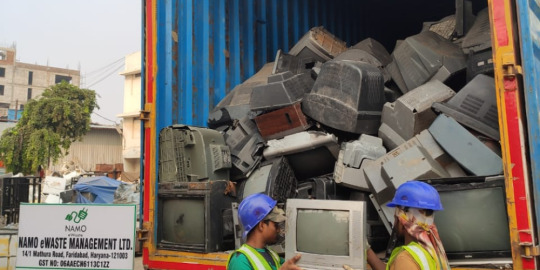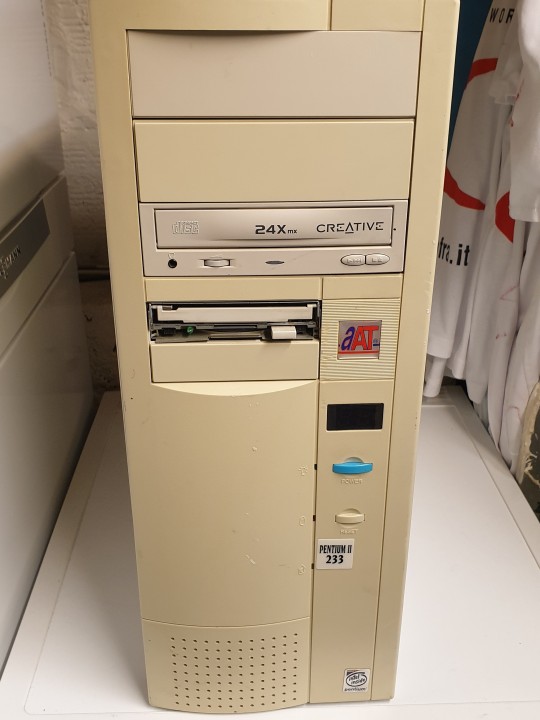#computer recycling
Text
Have you got an old Mac that is no longer supported by Apple? It's time to give it a new life.
How to install the latest MacOS on Mac hardware that is no longer officially supported using OpenCore Legacy Patcher.
I recently discovered this and it has been a game changer. Recently my partner needed a Mac for her music course, so we bought a 2012 Macbook Pro as it was cheap and on paper still had decent hardware for working with music. We were then disappointed to find out that it is no longer supported by Apple, and therefore can't run the latest version of Logic, which she needed to inter-op with the school comptuers. Just as we thought we had bought a less than useful computer, I found this video about OpenCore Legacy Patcher from Youtuber Action Retro.
It's a community made piece of software that allows you to install the latest version of MacOS on any Intel Mac, from the late 2000s onwards. All you need to do is download the application on a mac, it will then allow you to make a bootable USB drive for any version of MacOS you want, and you just need to choose the specific mac you are targeting from a list, and it "blesses" the bootable drive, allowing you to install it on your unsupported mac using the normal install process.

I tried it and it it worked perfectly on the 2012 Macbook Pro, and the latest version of MacOS Sonoma is running perfectly well on the 12 year old hardware. It also allowed us to install the latest version of Logic, so it's working great.
Props to the team for making this and allowing hardware that would otherwise be e-waste to continue to be usable with the modern internet and software. If you end up using it, please consider donating to the team as apparently they had to jump through some serious technical hoops to get this working. Here is the link again if you need it: https://dortania.github.io/OpenCore-Legacy-Patcher/
#mac#MacOS#Computers#OpenCore Legacy#OpenCore Legacy Patcher#Software#hardware#Apple#computer recycling#Action Retro
3K notes
·
View notes
Text
Responsible Disposal of Old Computers: A Comprehensive Guide
Understanding the Environmental Impact
Old computers contain various components, including heavy metals, plastics, and other materials that can harm the environment if not disposed of properly. Improper disposal, such as throwing computers in the trash or dumping them in landfills, can lead to pollution of soil, water, and air. Toxic substances like lead, mercury, and cadmium found in computer components can leach into the environment, posing serious health risks to humans and wildlife.
The Importance of Data Security
Aside from environmental concerns, disposing of old computers also raises issues related to data security. Many individuals and businesses store sensitive information on their computers, including personal data, financial records, and proprietary business information. Simply discarding a computer without properly wiping its hard drive can leave this data vulnerable to theft or misuse, potentially leading to identity theft, fraud, or other cybercrimes.
Responsible Disposal Methods
1. Recycling Programs
Computer recycling programs are an excellent option for responsibly disposing of old computers. Many electronics manufacturers and retailers offer recycling programs where consumers can drop off their old devices for proper disposal. These programs ensure that computers are dismantled and recycled in an environmentally friendly manner, with components being reused or safely disposed of to minimize environmental impact.
2. Donation
Another option for disposing of old computers responsibly is to donate them to charitable organizations, schools, or community centers. While the computer may no longer meet your needs, it could still be valuable to others who cannot afford to purchase new equipment. Before donating, be sure to wipe the hard drive to remove any personal or sensitive data.
3. Certified E-Waste Recyclers
For businesses or individuals with large quantities of old computers to dispose of, hiring a certified e-waste recycler may be the best option. These companies specialize in the proper disposal of electronic waste and ensure that computers are recycled in compliance with environmental regulations and data security standards. Working with a certified recycler provides peace of mind knowing that your old computers will be handled responsibly.
Steps to Ensure Data Security
1. Back Up Data
Before disposing of your old computer, it's essential to back up any important data you want to keep. Transfer files to an external hard drive, cloud storage service, or another computer to ensure you don't lose valuable information during the disposal process.
2. Data Wiping
Once you've backed up your data, it's crucial to wipe the hard drive to remove all personal and sensitive information. Simply deleting files or formatting the drive may not be enough to prevent data recovery. Use specialized software designed for data wiping to ensure that all data is securely erased.
3. Physical Destruction
For added security, consider physically destroying the hard drive before disposing of your old computer. This can be done using a hammer, drill, or other tools to ensure that the data is unrecoverable. Be sure to wear protective gear and dispose of the destroyed hard drive properly to prevent any potential hazards.
3R Technology
8002 S 208th St E105, Kent, WA 98032, United States
(206) 582-7100
#e-waste recycling#e-waste#electronicrecycling#e-waste recycling event#computer recycling#old electronics
0 notes
Text

Efficient Electronics Recycling: Trust and Value Since 2001
PN California Inc. is the premier choice for schools and educational institutions nationwide seeking a responsible avenue to retire their IT equipment. We prioritize:
Data Security: Our advanced data wiping techniques ensure your institution's information remains confidential, granting peace of mind.
Equipment Evaluation: Devices undergo rigorous testing for repurposing potential, ensuring sustainability and maximizing value.
Seamless Process: Tailored to the demands of the educational sector, our approach is straightforward and transparent, making IT retirement hassle-free.
For over two decades, we've combined technical expertise with an unwavering commitment to approachability and ease. Entrust us to derive the best value from your retired IT assets while championing environmental responsibility. Choose PN California Inc. - the nexus of value and values.
#Secure Data Destruction#IT Recycling#Information Technology Recycling#Electronics Recycling#Computer recycling
0 notes
Text
Safeguarding Cyberspace: The Power of Data Destruction
Introduction:
In the digital realm, data is the lifeblood of modern society. It fuels innovation, connects people, and drives businesses forward. However, this treasure trove of data also attracts nefarious actors seeking to exploit sensitive information for malicious purposes. The power of data destruction emerges as a formidable shield to safeguard cyberspace. This article explores the critical role of data destruction in fortifying data security, protecting individuals and organizations from data breaches, and preserving the integrity of our interconnected world.
The Digital Battleground: Understanding Data Vulnerability:
As technology intertwines with every aspect of our lives, the digital battleground becomes more pronounced. Cybercriminals and hackers relentlessly seek vulnerabilities to breach data defenses and compromise sensitive information. Recognizing the vulnerability of data is the first step in realizing the significance of data destruction as a safeguarding measure.
Data Destruction: The Shield against Data Breaches:
Data destruction serves as an impenetrable shield against data breaches. By rendering sensitive information unrecoverable, data destruction ensures that unauthorized parties cannot access or exploit discarded data. This proactive defense mitigates the risk of financial losses, reputational damage, and legal consequences arising from data breaches.
The Arsenal of Data Destruction Methods:
The power of data destruction lies in its diverse arsenal of methods. From data wiping and degaussing to physical destruction through shredding or pulverizing, each method ensures that data is erased beyond any possibility of retrieval. Employing these techniques instills confidence in data protection and reinforces the digital armor of organizations and individuals alike.
Compliance and Data Protection Laws:
In the ever-evolving landscape of data protection laws and regulations, compliance is a critical aspect of safeguarding cyberspace. Data destruction becomes an essential element in adhering to data protection laws, such as GDPR, HIPAA, and CCPA, as it demonstrates a commitment to responsible data management and security.
Sustainable Defense: Eco-Friendly Data Disposal:
Beyond its security benefits, data destruction also embraces sustainability. Recycling the materials from destroyed data storage devices reduces electronic waste, contributing to a circular economy and minimizing the environmental impact of technology consumption. An eco-friendly approach reinforces the defense of cyberspace while promoting environmental responsibility.
Cultivating a Security Mindset:
Safeguarding cyberspace requires a collective effort to cultivate a security mindset. Organizations and individuals must prioritize data security throughout the data lifecycle, including proper data destruction at the end of a device's life. By empowering everyone with the knowledge and tools for secure data disposal, we fortify the bulwark against cyber threats.
Conclusion:
Safeguarding Cyberspace: The Power of Data Destruction champions the significance of responsible data management in the digital age. By recognizing the vulnerability of data and embracing the power of data destruction, we protect ourselves from data breaches and cyber threats. Compliance with data protection laws ensures ethical data practices, while an eco-friendly approach contributes to sustainability. Let us unite in fortifying cyberspace through data destruction, where each deleted byte becomes a stepping stone in building a safer, more secure, and resilient digital world for generations to come.
#laptop recycling#computer Recycling#e waste recycling#e waste managem#recycling#sustainability#sustainable#circular economy#eco friendly#recycle
0 notes
Text
The Hidden Dangers of Improper E-Waste Disposal and the Benefits of WEEE Recycling
Introduction:
In our technologically advanced world, electronic devices have become an integral part of our lives. However, the rapid pace of innovation and consumer demand has led to a significant increase in electronic waste, or e-waste. Improper disposal of e-waste poses hidden dangers to the environment and human health. This article explores the risks associated with improper e-waste disposal and highlights the benefits of WEEE (Waste Electrical and Electronic Equipment) recycling.
Hidden Dangers of Improper E-Waste Disposal:
Environmental Contamination: Improper disposal of e-waste, such as throwing devices in landfills or incinerating them, releases toxic substances into the environment. Electronic devices contain hazardous materials like lead, mercury, cadmium, and brominated flame retardants. These substances can leach into soil, contaminate water sources, and pollute the air, leading to ecological imbalances and long-term damage to ecosystems.
Soil and Water Pollution: Toxic substances from e-waste can seep into the soil, contaminating agricultural lands and affecting crop growth. When these contaminants reach water bodies, they can pollute freshwater sources, harming aquatic life and posing risks to human health through the food chain. The accumulation of heavy metals and chemicals in the environment can have far-reaching consequences on ecosystems and biodiversity.
Health Risks: Improper handling and disposal of e-waste expose workers and nearby communities to health hazards. Recycling operations in informal or unregulated settings may involve manual dismantling and extraction of valuable materials, leading to direct exposure to toxic substances. Inhalation of toxic fumes, ingestion of contaminated food or water, and skin contact with hazardous materials can result in various health issues, including respiratory problems, neurological disorders, organ damage, and even cancer.
Benefits of WEEE Recycling:
Resource Conservation: WEEE recycling plays a vital role in conserving valuable resources. Electronic devices contain precious metals, such as gold, silver, and copper, as well as other reusable materials like plastic and glass. Recycling e-waste allows for the extraction and recovery of these resources, reducing the need for raw material extraction through mining and minimizing the strain on natural resources.
Reduction of Energy Consumption: Recycling electronic waste requires less energy compared to the production of new devices from raw materials. Extracting metals from e-waste consumes significantly less energy and emits fewer greenhouse gases compared to the mining and refining processes. By recycling e-waste, we conserve energy resources and contribute to the global efforts to combat climate change.
Economic Opportunities: WEEE recycling presents economic opportunities and job creation. The establishment of recycling facilities and the demand for skilled workers in the recycling sector contribute to employment and economic growth. Additionally, the refurbishment and resale of functional electronic devices provide affordable options for consumers and support the development of a secondary market.
Environmental Protection: WEEE recycling plays a crucial role in minimizing environmental pollution. Proper recycling processes ensure the safe disposal and management of hazardous materials found in e-waste, preventing their release into the environment. By reducing the amount of e-waste sent to landfills and incinerators, recycling helps protect ecosystems, conserve natural resources, and mitigate the overall environmental impact of electronic devices.
Promoting Responsible E-Waste Disposal and WEEE Recycling:
Raise Awareness: Educating the public about the hidden dangers of improper e-waste disposal is crucial. Awareness campaigns and educational programs can inform individuals about the risks and benefits of proper e-waste management. Sharing information about local recycling options and providing guidance on responsible disposal practices can encourage individuals to take action.
Implement Legislation and Regulations: Governments should enact and enforce legislation that promotes responsible e-waste management. Extended Producer Responsibility (EPR) policies can hold manufacturers accountable for the entire lifecycle of their products, including their disposal. Governments can also provide incentives for recycling and establish proper infrastructure for collection, recycling, and safe disposal of e-waste.
Support Recycling Initiatives: Collaboration among various stakeholders is essential for effective e-waste recycling. Governments, manufacturers, recycling facilities, and consumers should work together to develop and support recycling initiatives. This includes the establishment of convenient collection points, the improvement of recycling technologies, and the encouragement of sustainable practices throughout the electronics industry.
Conclusion:
The improper disposal of e-waste poses significant risks to the environment and human health. By understanding the hidden dangers associated with improper e-waste disposal and embracing WEEE recycling, we can mitigate these risks and reap the benefits of responsible e-waste management. Through awareness, effective legislation, and collaborative efforts, we can protect the environment, conserve valuable resources, and safeguard the well-being of current and future generations.
0 notes
Text
Optimizing Resources: The Power of Effective IT Asset Management
Introduction:
In today's digital landscape, businesses rely heavily on technology and IT assets to drive productivity, streamline operations, and gain a competitive edge. However, managing these assets efficiently can be a complex task. This is where effective IT asset management (ITAM) comes into play. In this article, we will explore the power of IT asset management, its benefits for organizations, and how it enables businesses to optimize their resources for improved efficiency and cost savings.
Comprehensive Asset Visibility and Inventory Management:
IT asset management provides organizations with a holistic view of their technology infrastructure. By accurately tracking and cataloging IT assets, businesses gain better visibility into their hardware, software, licenses, and warranties. This enables efficient inventory management, reduces the risk of over-purchasing or under-utilizing assets, and helps optimize resource allocation.
Cost Savings through Lifecycle Planning:
Effective IT asset management involves planning and managing the entire lifecycle of IT assets, from acquisition to disposal. By strategically assessing the needs of the organization, ITAM helps businesses make informed decisions regarding the procurement, utilization, and retirement of assets. This results in cost savings by eliminating unnecessary purchases, optimizing asset utilization, and extending the lifespan of IT equipment.
Enhanced Software License Compliance:
Software license compliance is a critical aspect of IT asset management. By maintaining accurate records of software licenses, organizations can ensure they are compliant with licensing agreements, avoiding potential legal and financial risks. ITAM helps businesses track software usage, manage license renewals, and implement effective license management practices, thereby optimizing software investments and reducing compliance-related issues.
Improved Efficiency and Productivity:
Efficient IT asset management leads to improved operational efficiency and productivity. By having a centralized system to track and manage assets, businesses can easily locate and deploy resources when needed. This reduces downtime, enhances employee productivity, and minimizes disruptions caused by asset-related issues. ITAM also enables proactive maintenance and timely upgrades, ensuring that IT assets are functioning optimally.
Enhanced Security and Risk Mitigation:
IT asset management plays a crucial role in maintaining data security and mitigating risks. Through asset tracking and inventory management, businesses can ensure that security measures are implemented across all IT assets. This includes regular software updates, vulnerability patching, and monitoring for security breaches. ITAM also helps identify and address potential risks, such as outdated or unsupported software, minimizing the likelihood of cybersecurity incidents.
Conclusion:
Effective IT asset management empowers organizations to optimize their resources, reduce costs, improve efficiency, and mitigate risks. By implementing comprehensive ITAM practices, businesses can gain better visibility into their technology infrastructure, streamline asset management processes, ensure compliance, and enhance overall productivity. Embracing the power of IT asset management enables organizations to leverage their technology investments for long-term success in today's digital age.
0 notes
Text

[Image description: A series of posts from Jason Lefkowitz @[email protected] dated Dec 08, 2022, 04:33, reading:
It's good that our finest minds have focused on automating writing and making art, two things human beings do simply because it brings them joy.
Meanwhile tens of thousands of people risk their lives every day breaking down ships, a task that nobody is in a particular hurry to automate because those lives are considered cheap https://www.dw.com/en/shipbreaking-recycling-a-ship-is-always-dangerous/a-18155491
(Headline: 'Recycling a ship is always dangerous.' on Deutsche Welle)
A world where computers write and make art while human beings break their backs cleaning up toxic messes is the exact opposite of the world I thought I was signing up for when I got into programming
/end image description]
#artificial intelligence#computers#programming#technology#Jason Lefkowitz#Mastodon#labor#transcription#capitalism#corporations#exploitation#class struggle#creativity#humans#safety#survival#vehicles#recycling#generative images#machine learning
28K notes
·
View notes
Text
Find the Best Computer Disposal Service in Portland

At Green Century Recycling, we offer secure computer disposal services to ensure that all your data is untraceable. Our team of experts will provide your business with a customized plan of action, tailored to your specific IT asset disposition needs and requirements, at an absolutely affordable cost. Get in touch with us!
1 note
·
View note
Text
Best E Waste Recycling - Secure Hard Drive Destruction (SHDD)
We supply the most secure end-to-end disposal environment for ICT and IT media. E Waste Recycling provides the highest level of end-of-life, turn-key shredding, and data destruction services in Australia, backed by 5+ years of experience in recycling technologies.
#e waste recycling#e-waste recycling#electronic waste disposal#electronic#recycling australia#electronic recycling#computer recycling
0 notes
Text
The Importance of Recycling a computer

Recycling your computer not only has a positive impact on the environment, It also saves you money. Instead of disposing of your old computer in city landfills, consider recycling it.
if we dump our devices into a landfill, we are endangering the environment. Recycling electronics has a lot of advantages for the environment.
To Know more - https://namoewaste.com/the-importance-of-recycling-a-computer/
0 notes
Text

59 notes
·
View notes
Text
The Importance of Computer Recycling for a Greener Tomorrow

Introduction: Understanding the Need for Computer Recycling
In today's technologically advanced world, computer recycling has emerged as a critical component of environmental sustainability efforts. With the rapid pace of technological innovation, the turnover rate of electronic devices, including computers, has increased exponentially. As a result, the proper disposal and recycling of these devices have become imperative to the environmental impact of electronic waste (e-waste).
Environmental Impact of E-Waste
The improper disposal of computers and other electronic devices poses significant environmental challenges. E-waste contains hazardous materials such as lead, mercury, cadmium, and brominated flame retardants, which can leach into the soil and water, contaminating the environment and posing health risks to humans and wildlife alike. Additionally, e-waste contributes to air pollution when incinerated, releasing harmful toxins into the atmosphere.
Benefits of Computer Recycling
1. Resource Conservation
Computer recycling helps conserve valuable natural resources by recovering materials such as metals, plastics, and glass from outdated devices. These materials can be reused in the manufacturing of new products, reducing the need for virgin resources and lowering energy consumption associated with extraction and processing.
2. Reduction of Landfill Waste
By diverting computers from landfills, recycling initiatives help alleviate the burden on waste management systems and reduce the volume of e-waste accumulating in landfills. This, in turn, helps prevent soil and water contamination while minimizing greenhouse gas emissions produced by decomposing electronic waste.
3. Energy Savings
The recycling process requires less energy than the extraction and refinement of raw materials, leading to significant energy savings. By conserving energy, computer recycling contributes to the reduction of greenhouse gas emissions and climate change.
Promoting Sustainable Practices
1. Consumer Education
Educating consumers about the importance of computer recycling and providing convenient recycling options can encourage responsible disposal practices. Retailers and manufacturers can play a crucial role by offering take-back programs and promoting the purchase of refurbished or upgradable devices.
2. Corporate Responsibility
Businesses can demonstrate corporate responsibility by implementing environmentally sustainable practices, including responsible e-waste management. Adopting circular economy principles, such as product design for recyclability and extended producer responsibility, can minimize the environmental footprint of electronic products throughout their lifecycle.
3. Government Regulations
Government regulations play a vital role in shaping e-waste management policies and driving industry compliance. Implementing comprehensive e-waste legislation, including extended producer responsibility laws and strict enforcement measures, can ensure proper e-waste collection, e-waste recycling, and disposal practices.
3R Technology
8002 S 208th St E105, Kent, WA 98032, United States
(206) 582-7100
0 notes
Text


Nice find yesterday at my office tech trash.
First look : SDRAM is missing and the PSU is dead. Hope the rest is OK.
150 notes
·
View notes
Text
Green Computing: Advancing Sustainability through Computer Recycling
Introduction
Green computing is an essential concept that focuses on minimizing the environmental impact of information technology (IT) systems. One key aspect of green computing is computer recycling, which plays a vital role in advancing sustainability and reducing electronic waste. By responsibly managing the lifecycle of computers, from production to disposal, we can promote resource conservation, energy efficiency, and environmental stewardship. In this blog post, we will explore how computer recycling contributes to green computing and the sustainable use of technology.
Extending the Lifespan of Computers
Computer recycling aims to extend the lifespan of computers, reducing the need for new device production and resource consumption. Through recycling and refurbishment, older computers can be repaired, upgraded, and repurposed for secondary use. By maximizing the utility of existing devices, we minimize the environmental impact associated with manufacturing new computers, such as raw material extraction, energy consumption, and greenhouse gas emissions.
Resource Conservation and Waste Reduction
Computer recycling promotes resource conservation by recovering valuable materials from discarded devices. Components like metals, plastics, and glass can be extracted, processed, and reused in the manufacturing of new products. This reduces the demand for virgin resources and minimizes the environmental impact of resource extraction, including habitat destruction, water pollution, and energy consumption. Additionally, recycling computers helps divert e-waste from landfills, preventing the release of hazardous substances into the environment and reducing the overall volume of waste.
Energy Efficiency and Carbon Footprint Reduction
The production, use, and disposal of computers consume significant amounts of energy, contributing to carbon emissions and climate change. Through recycling, energy-efficient components can be salvaged and utilized in the refurbishment of older computers. This results in more energy-efficient devices and reduces the carbon footprint associated with their operation. Furthermore, recycling reduces the energy required for raw material extraction, manufacturing, and transportation, leading to additional energy savings and emissions reduction.
Responsible E-Waste Management
Electronic waste contains hazardous materials that can harm the environment and human health if not handled properly. Computer recycling ensures the safe and responsible disposal of e-waste, preventing the release of toxic substances into the air, soil, and water. Certified recycling facilities adhere to strict environmental standards, employing techniques that minimize the risk of pollution and contamination. By choosing reputable recyclers and following proper disposal practices, we contribute to a healthier environment and protect vulnerable ecosystems.
Encouraging Sustainable IT Practices
Computer recycling serves as a catalyst for promoting sustainable IT practices. It raises awareness about the environmental impact of technology and encourages individuals, organizations, and manufacturers to adopt greener approaches. Recycling initiatives can inspire the development of energy-efficient computers, the use of environmentally friendly materials, and the implementation of product stewardship programs. By integrating sustainability into IT decision-making, we can drive innovation and create a more sustainable and responsible technology sector.
Conclusion
Computer recycling is a fundamental component of green computing, advancing sustainability and responsible IT practices. By extending the lifespan of computers, conserving resources, reducing waste, and promoting energy efficiency, we can minimize the environmental impact of technology. It is essential for individuals, organizations, and policymakers to prioritize computer recycling and support initiatives that facilitate responsible e-waste management. By embracing green computing principles and incorporating computer recycling into our practices, we can build a more sustainable future and protect our planet for generations to come.
0 notes
Text
Computer Recycling: Transforming E-Waste into Environmental Solutions
Introduction:
As technology rapidly advances, the accumulation of electronic waste, or e-waste, has become a pressing environmental concern. Disposing of computers in landfills poses significant risks to both human health and the planet. However, through the practice of computer recycling, we can transform e-waste into environmental solutions. In this blog post, we will explore the importance of computer recycling, its positive impact on the environment, and how it contributes to a more sustainable future.
The Growing Challenge of E-Waste:
With the constant innovation and rapid turnover of technology, electronic devices, including computers, have shorter lifespans than ever before. As a result, the volume of e-waste is on the rise. E-waste contains hazardous materials such as lead, mercury, and cadmium, which can contaminate soil, water, and air if not properly managed. Computer recycling addresses this challenge by diverting e-waste from landfills and implementing responsible disposal practices.
Resource Recovery and Conservation:
Computers consist of various valuable resources, including metals like gold, silver, and copper, as well as plastics and glass. These materials require significant energy and resources to extract and manufacture. Computer recycling allows for the recovery of these valuable resources, reducing the need for new raw materials. By recycling computers, we conserve natural resources, reduce energy consumption, and alleviate the environmental impact associated with resource extraction and production.
Environmental Benefits of Computer Recycling:
a) Reduction of Landfill Waste: By recycling computers, we prevent these devices from ending up in landfills. This not only reduces the volume of waste but also helps mitigate the release of hazardous substances into the environment, protecting ecosystems and human health.
b) Energy Savings: Recycling computers requires less energy compared to the manufacturing of new devices. The energy saved through recycling can be substantial, contributing to a reduction in greenhouse gas emissions and mitigating climate change.
c) Pollution Prevention: E-waste contains toxic substances that, when not properly handled, can contaminate soil, water sources, and air. Computer recycling ensures that these harmful materials are safely removed and processed, preventing pollution and minimizing the impact on the environment.
Responsible Recycling Practices:
Computer recycling follows a systematic process that ensures the proper handling and disposal of electronic devices:
a) Collection: Computers are collected from individuals, businesses, or designated collection centers.
b) Data Destruction: Secure data wiping or destruction is performed to protect sensitive information and maintain data privacy.
c) Component Separation: Computers are disassembled, and components are sorted for recycling or refurbishment.
d) Material Recovery: Valuable materials are extracted, including metals, plastics, and glass, for reuse in manufacturing processes.
e) Proper Disposal: Any remaining materials that cannot be recycled are disposed of responsibly, following environmental regulations and guidelines.
Conclusion:
Computer recycling is a crucial practice for transforming e-waste into environmental solutions. By recycling computers, we reduce landfill waste, conserve valuable resources, prevent pollution, and contribute to a more sustainable future. As individuals and businesses, let us embrace computer recycling as a responsible and impactful way to protect the environment, preserve resources, and pave the way for a greener and cleaner world.
0 notes